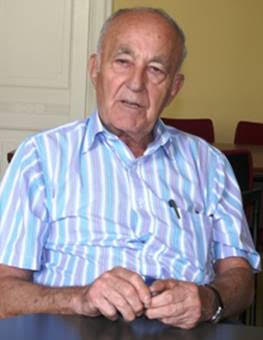
THE VOICE OF INTERNATIONAL LITHUANIA
|
VilNews has its own Google archive! Type a word in the above search box to find any article.
You can also follow us on Facebook. We have two different pages. Click to open and join.
|
Featured black
- Posted by - (11) Comment
The Knights of Lithuania
keep on fighting

Knights of Lithuania #144 protesting Washington DC in 1990.
The Knights of Lithuania was founded as a national youth organization in 1913 by Mykolas Norkunas, the “father of the Knights of Lithuania.” Mykolas began his campaign to form a national Lithuanian organization by publishing appeals in the Lithuanian language press in various cities throughout the United States. His purpose was to unite the Lithuanian youth living in the USA, and through them, preserve Lithuanian culture and restore freedom to Lithuania, which was occupied at the time by Russia and Germany. Members placed their hope in their children, which is the basis of the organization. The Knights of Lithuania is a national non-profit organization of dedicated men and women of Lithuanian ancestry. Believing in the strength of the motto: "For God and Country," the Knights of Lithuania aspire to keep alive among its members an appreciation and understanding of the Lithuanian language, customs, and culture, while advancing the values and foundation of the Roman Catholic beliefs.

1977 Knights of Lithuania #144 Receiving Proclamation.
(L-R) Helen Chekso, Bernice Mikatavage, Msgr, Joseph Neverauskas, Anne Wargo, receiving Proclamation from Commissioner, Al Matunas, Anne Marie Slevokis, Fr. Casimir Pugevicius of the Lithuanian Catholic Religious Aid, Rita Slevokis, and Fr. Al Bartkus.
Many of the Lithuanian immigrants settled in the Anthracite coal region of Northeastern Pennsylvania in the late 19th and early 20th centuries. They were simple, ordinary people from small towns and villages of the Suvalkija region of Lithuania. The men labored long and hard hours in the coal mines. Their parish became the center of social and religious life and their life philosophy was deeply rooted in the teachings of Jesus Christ. The annual “Lithuanian Days” is a well known memory and ongoing tradition for Lithuanian-Americans living in Pennsylvania. It started in 1914 by the Lithuanian Catholic Priest League. The priests were troubled by problems faced by incoming immigrants such as poor living conditions and the dangerous work environment from the mines. A change needed to occur and they pondered on how they could lift the morale and create a better lifestyle for Eastern European immigrants. They cultivated the idea of a massive festival that rejoiced in life, family, community, and pride for their native land. Lithuanian Days at Lakeside Park was the first recorded ethnic celebration in the United States. Lithuanian immigrants enjoyed ethnic food, drink, tradition, and song every year. In 1922 Lithuanian Days moved to Lakewood Park. All proceeds from the event went to Lithuanian charities. Thus no matter how difficult life seemed in America, most of the early immigrants idealized supported each other and idealized the splendor of nature and the memory of a simpler life in Lithuania.
The Frackville Council #144 joined the Knights of Lithuania in 1977 with about 25 members. Its first President was Bernice Mikatavage. Over the years Council # 144 grew, to over 130 members! Meetings were held after the Lithuanian Mass with Father Bartkus each month. Throughout the years, Council #144 worked diligently on Lithuanian Affairs. Members wrote letters, sent telegrams, went on demonstrations, and did whatever we could for the Lithuanian cause.
Eventually Council #144 became the primary sponsor for “Lithuanian Days.” At the 1978 “Lithuanian Days” in Lakewood Park our guest was the author, Simas Kidurka. A dinner was held in his honor where he signed his book, For Those at Sea. At the Park, we continued to enjoy Lithuanian dancers, ethnic food and the Council Lithuanian Choir. Vendors came with lovely Lithuanian souvenirs, crafts and books. Each year we had one prominent Lithuanian speaker and all profits were donated to Lithuanian Foundations especially Lithuanian Catholic Religious Aid, St. Casimir’s Pontifical College in Rome, and Lithuanian Orphan Relief.

Simas Kudirka Signs Autographs at St. Casimir Reception, St. Clair, PA
(L to R) Helen Ambrose, Annie Morgalis,Terri Taronis, Anna Yourkonis and Leona Taronis.
Sadly, Lakewood Park closed in 1984. The festival was held in various locations, until thankfully, we were able to continue the Lithuanian Days celebration at the Schuylkill Mall, in Frackville, PA. In fact this year on, August 11 and 12, 2012 we are celebrating our 98th year, making “Lithuanian Days” the longest consecutive ethnic festival in the USA! The festival allows Council #144 to share, spread, and remember Lithuanian heritage. It is a festival of Lithuanian culture, cuisine, song and dance.
Before Lithuania regained independence members traveled often to Washington, DC and New and York City to participate in Lithuanian Independence demonstrations at the Russian Embassy. We also participated in demonstrations at the United Nations. While Lithuania was still under Soviet rule, council members were asked by Rev. Casimir Pugivicius, an associate of Lithuanian Catholic Religious Aid, to donate medication and Bibles to Lithuania. Transporting the donated supplies to Lithuania was an extremely dangerous and risky task. Ten members including Anne KlizasWargo and Annie Morgalis agreed to embark on this venture. They divided the pharmacy supplies among them and boarded a plane for the USSR . After arriving in Vilnius they secretly gathered the medication and traveled to a third floor apartment. Two women opened the apartment door. For security reasons, they did not speak and only communicated using a “magic slate” pad or doodle pad. They wrote “Who are you and where are you from?” Our members wrote that they were from the United States and were asked by Father Pugivicius, to bring desperately needed medical supplies. The women were extremely overjoyed and elated and tears of joy began to form in their eyes. Our Council members later discovered that the two women were underground nuns. Members also collected needed clothing that was sent to Lithuanian schools and orphanages using VILTIS-HOPE Lithuanian Relief Parcel Service.
Many of our members donated gorgeous Lithuanian treasures to help create a Lithuanian Cultural Museum. The council obtained a building near the Annunciation BVM Church in Frackville and transformed it into a cozy and delightful museum. It was opened in November of 1982. Exhibits present the chronology of the life of the typical Lithuanian immigrant who arrived in the Anthracite Region of Pennsylvania at the turn of the century. Thru Russian Army discharge papers, passports, rubles (or Lithuanian money), clothing and straw suitcase, the story unfolds. The museum also contains an extensive library of rare Lithuanian books, stunning Lithuanian artifacts, items from the early immigrants who came to work in the coal mines, colorful coverlets, tablecloths, and other weavings in traditional Lithuanian designs, straw art, marguciai eggs decorated by members Christine Luschas and Ona Morgaliene, and unique mushroom art designed Ona Morgaliene. We wish future generations of Lithuanians will be able to use the many volumes of information at the Center for research, or that they may just cherish the beautiful artifacts of their ancestral heritage. Now the museum is open by appointment only.

Opening of the Lithuanian Museum & Cultural Center, November, 1982.
(L-R) Anne Wargo, Anne Sekora, Annie Morgalis, and Bernice Mikatavage.
The worries, fears, and obligations which many of the early immigrants felt for the land of their forefathers are still alive in the hearts and minds of Lithuanian-Americans today! Our council still contributes to Lithuanian charitable works and the Lithuanian Orphan Relief sending much needed aid overseas to orphanages in remote villages of Lithuania. The Knights of Lithuania Council #144 is extremely active and strives to keep Lithuanian heritage alive by sponsoring the annual Lithuanian Days, hosting a traditional Christmas Kucios Dinner, creating cultural displays/presentations, educational lectures, promoting tourism to Lithuania, while maintaining an informative website, blog and Facebook page. Please visit our website: www.kofl144.weebly.com and our Facebook Page at www.facebook.com/knightsoflithuania144.

Amber District Meeting March 11, 2012
K of L C-144 members with their "Third Degree" medals and certificates.
Row 1 (L-R) Meredeth Domlakes, Elizabeth Fry, Carol Luschas, and Antoinette Pancerella.
Row 2 (L-R) Anthony Richtus, Margaret Valinsky, Peg Hess, James Hess, and Elaine Luschas.

Lithuanian Days 2007, Bernice

LT Days 2011, Heritage Room.
Resources
Lithuanian Museum and Cultural Center Brochure Pages 1-2
Sakalas, Ingas. Lieruvos Vyciai Amerikoje (Knights of Lithuania in America) History of the Knights of Lithuania Spaude Draugo Spaustuve Cikagoje.
Vytis. Knights of Lithuania Vol. 78: No. 4 79th Annual Convention Host: Anthracite C-144 Pgs. 19-20
Wargo, Anne Telephone Interview. March 13, 2012
Wydra, Marion. The Valley Plus Magazine. 97th Lithuanian Days to Be Held August 13 and 14 August: 2011 Pgs. 13-14
- Bookmark :
- Digg
- del.icio.us
- Stumbleupon
- Redit it
- Posted by - (0) Comment
“Our ancestors always whisper in our ears, they beg to be understood”
 |
Last week we brought an article with the latest statistics from the World Health Organization, showing that Lithuania again is on top when it comes to suicides – with 61,3 men and 10,4 women per 100,000 inhabitants deciding to end their lives this sad way – annually.
Dainius Puras, a Lithuanian psychiatrist, explains how it is the uncertainty and unpredictability of the economic situation that have such a detrimental effect: "People don't like change,” he says, referring to Lithuania’s 20-year period of dramatic social and economic change since the fall of the Soviet Union in 1991”. |
Response from Vijole Arbas in Kaunas:
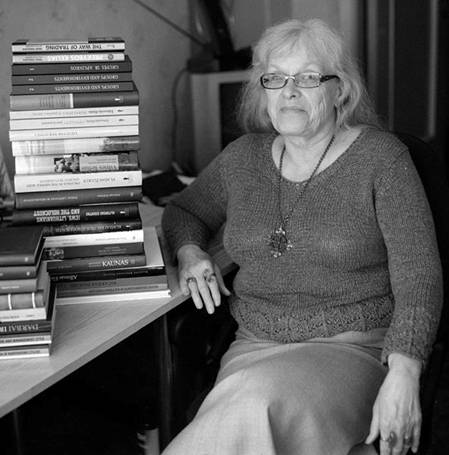
This cannot be the only explanation -- we are plagued by bad spirits of our past, we can't seem to "clean up", to make amends.
Jūratė Sučylaitė wrote a novel (can't recall the exact title Pokalbis su Ragana, somthing like that). Her thesis (if I may call it that) is that our ancestors always whisper in our ears. They beg to be understood. That does not mean to glorify but understand, realize why, forgive, make amends. People want to drown out those voices of the dead by alcoholism, suicide. It is a haunting story that rings very true to me.
On the other hand, the ancestors of American Lithuanians also whisper, also had the sins of betrayal against one's fellow man as well as of victimization. Why don't they hear those ghosts?
A film by V. Landsbergis Jr., When I Was a Partisan, also deals with this sort of concept.
 |
Irene Simanavicius: There is so much more to this...so much more. Those of us that grew up in North America and have visited Lithuania got to know and love people we have met during our visits. People young and old shared some of the stories that were heart wrenching. I agree with Vijole Arbas 100 %. |
- Bookmark :
- Digg
- del.icio.us
- Stumbleupon
- Redit it
- Posted by - (2) Comment
“Our ancestors always whisper in our ears, they beg to be understood”
 |
Last week we brought an article with the latest statistics from the World Health Organization, showing that Lithuania again is on top when it comes to suicides – with 61,3 men and 10,4 women per 100,000 inhabitants deciding to end their lives this sad way – annually.
Dainius Puras, a Lithuanian psychiatrist, explains how it is the uncertainty and unpredictability of the economic situation that have such a detrimental effect: "People don't like change,” he says, referring to Lithuania’s 20-year period of dramatic social and economic change since the fall of the Soviet Union in 1991”. |
Response from Vijole Arbas in Kaunas:

This cannot be the only explanation -- we are plagued by bad spirits of our past, we can't seem to "clean up", to make amends.
Jūratė Sučylaitė wrote a novel (can't recall the exact title Pokalbis su Ragana, somthing like that). Her thesis (if I may call it that) is that our ancestors always whisper in our ears. They beg to be understood. That does not mean to glorify but understand, realize why, forgive, make amends. People want to drown out those voices of the dead by alcoholism, suicide. It is a haunting story that rings very true to me.
On the other hand, the ancestors of American Lithuanians also whisper, also had the sins of betrayal against one's fellow man as well as of victimization. Why don't they hear those ghosts?
A film by V. Landsbergis Jr., When I Was a Partisan, also deals with this sort of concept.
 |
Irene Simanavicius: There is so much more to this...so much more. Those of us that grew up in North America and have visited Lithuania got to know and love people we have met during our visits. People young and old shared some of the stories that were heart wrenching. I agree with Vijole Arbas 100 %. |
- Bookmark :
- Digg
- del.icio.us
- Stumbleupon
- Redit it
Happy Stork Day!!
- Posted by - (1) Comment
|
The white stork (gandras) is usually felt to be the national bird of Lithuania. Lithuanians believe that storks bring harmony to the families on whose property they nest; they have also kept up the tradition of telling their children that storks bring babies. Stork Day is celebrated on 25 March with various archaic rituals: gifts for children, attributed to the storks, such as fruits, chocolates, pencils, and dyed eggs, which are hung on tree branches and fences; snakes are caught, killed and buried under the doorstep; straw fires are lit. Notably, Lithuania is a beneficial and important habitat for these birds: it has the highest known nesting density in the world! |
 |
- Bookmark :
- Digg
- del.icio.us
- Stumbleupon
- Redit it
Lithuania has the world’s highest suicide rate
- Posted by - (0) Comment
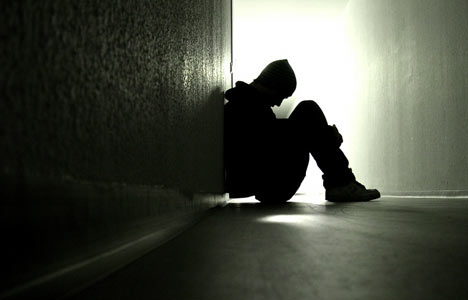
Latest statistics from the World Health Organization show that Lithuania again is on top when it comes to suicides – with 61,3 men 10,4 women per 100,000 inhabitants deciding to end their lives this sad way – annually.
Dainius Puras, a Lithuanian psychiatrist, explains how it is the uncertainty and unpredictability of the economic situation that have such a detrimental effect: "People don't like change,” he says, referring to Lithuania’s 20-year period of dramatic social and economic change since the fall of the Soviet Union in 1991”.
He describes the reaction to freedom in 1989: "Many people could not manage to cope with this change, with this huge societal stress . . . [they] regressed to destructive or self-destructive behaviour." The stress, he says, prompted an unprecedented crisis of mortality, one that still exists. In Lithuania, with a population of just three million, 5,000 people die every year because of "external causes" - suicide, homicide, violence. He describes it as an epidemic.
Lithuania - a prophetic microcosm of the global crisis?
Puras sees Lithuania's experience as a prophetic microcosm of the global crisis: a society undergoing enormous stress because of the effects of a toxic system, culminating in an “explosion" in the form of a financial crisis. He also points out a strange trend: the more severe the threat to human life, the better societies and individuals seem to fare in their mental health. "History shows that when it is a real crisis like war, or when people are starving, there is a huge decrease in mental health problems, including suicide. During the war you have to survive physically; existential problems are not so important. Suicide is mainly the price we pay for civilisation."
Figures for the UK support his theory - during the First World War, the suicide rate dropped to 8.5 per 100,000. It then leapt to 13.5 in the interwar years, and fell again during the Second World War to 9.2. Immediate, life-threatening crisis, Puras says, creates a sense of purpose: there's not as much time to worry about yourself.
( From an article in “New Statesman”, by Sophie Elmhirst)
Lithuanian Suicide Hotline
Youth Psychological Aid Centre -Vilnius Youth Line
Jaunimo psichologinés paramos centras
Rasu g.20, LT-11351 VILNIUS
Hotline: 8-800 2 8888
Website: jppc.lt
Hours: Mon, Tues, Wed, Thurs, Fri, Sat, Sun: 16:00 - 07:00
Suicides per 100,000 people per year
The following is a list of suicide rates by country according to data from the World Health Organization, in which a country's rank is determined by its total rate deaths officially recorded as suicides in the most recent available year, last updated in 2011.
Male and female suicide rates are out of total male population and total female population, respectively (i.e. total number of male suicides divided by total male population). The total rate of suicides is based on the total number of suicides divided by the total population rather than merely the average of the male and female suicide rates, because the gender ratio in most countries is not 1:1. Year refers to the most recent year that data was available for a particular country.
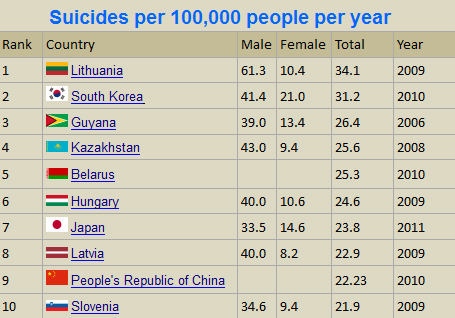
Other articles:
http://www.elnet.lt/psychoanalysis/psychoanalysis/Vilmos2.htm
http://eurpub.oxfordjournals.org/content/10/2/101.full.pdf
- Bookmark :
- Digg
- del.icio.us
- Stumbleupon
- Redit it
- Posted by - (3) Comment
Lithuania has the world’s
highest suicide rate

Latest statistics from the World Health Organization show that Lithuania again is on top when it comes to suicides – with 61,3 men 10,4 women per 100,000 inhabitants deciding to end their lives this sad way – annually.
Dainius Puras, a Lithuanian psychiatrist, explains how it is the uncertainty and unpredictability of the economic situation that have such a detrimental effect: "People don't like change,” he says, referring to Lithuania’s 20-year period of dramatic social and economic change since the fall of the Soviet Union in 1991”.
He describes the reaction to freedom in 1989: "Many people could not manage to cope with this change, with this huge societal stress . . . [they] regressed to destructive or self-destructive behaviour." The stress, he says, prompted an unprecedented crisis of mortality, one that still exists. In Lithuania, with a population of just three million, 5,000 people die every year because of "external causes" - suicide, homicide, violence. He describes it as an epidemic.
Lithuania - a prophetic microcosm of the global crisis?
Puras sees Lithuania's experience as a prophetic microcosm of the global crisis: a society undergoing enormous stress because of the effects of a toxic system, culminating in an “explosion" in the form of a financial crisis. He also points out a strange trend: the more severe the threat to human life, the better societies and individuals seem to fare in their mental health. "History shows that when it is a real crisis like war, or when people are starving, there is a huge decrease in mental health problems, including suicide. During the war you have to survive physically; existential problems are not so important. Suicide is mainly the price we pay for civilisation."
Figures for the UK support his theory - during the First World War, the suicide rate dropped to 8.5 per 100,000. It then leapt to 13.5 in the interwar years, and fell again during the Second World War to 9.2. Immediate, life-threatening crisis, Puras says, creates a sense of purpose: there's not as much time to worry about yourself.
( From an article in “New Statesman”, by Sophie Elmhirst)
Lithuanian Suicide Hotline
Youth Psychological Aid Centre -Vilnius Youth Line
Jaunimo psichologinés paramos centras
Rasu g.20, LT-11351 VILNIUS
Hotline: 8-800 2 8888
Website: jppc.lt
Hours: Mon, Tues, Wed, Thurs, Fri, Sat, Sun: 16:00 - 07:00
SUICIDE IN LITHUANIA
Lithuania Takes the Dubious Honor of Having Highest Suicide Rate in World
An article from year 2000, by LEYLA ALYANAK © Earth Times News Service, VILNIUS, Lithuania
This tiny former Soviet republic on the shores of the Baltic Sea has acquired a dubious distinction: It has the highest suicide rate in the world. Suicides have increased steadily since independence in 1990, especially among young men (up 195 percent) and women aged 50 to 59 (up 106 percent). In 1996 the suicide rate hit an all-time high of 46.4 per 100,000 people before settling at 44 in 1997. These figures compare with 38 per 100,000 in Russia, 34 in Estonia, 33 in Hungary, 20 in Switzerland, seven in Spain, and three in Greece.
According to one specialized report on suicide, more people kill themselves in Lithuania each day (four to five) than die in traffic accidents. But these figures are relatively new and suicide has never been a traditional characteristic here. Before World War II, suicide rates in Lithuania were far below those of many other Eastern European countries. Now, the Baltic States, with Lithuania up front, are leading the pack. "Suicide cannot be explained using only individual reasons," said Dr. Danute Gailiene, a psychologist and specialist in social issues. "It is the consequence of a complex process." That process includes decades of Soviet domination, a dramatic transition period, the amount of media coverage given to suicides, and a certain perceived helplessness toward all of the above. These factors are intensified by the absence of a national suicide prevention strategy and a lack of in-depth research into the problem of suicide. Experts say radical reforms in Lithuanian society have brought about a crisis in values, while growing economic unease has combined with increasing psychological and social insecurity and feelings of helplessness. Still, they cannot pinpoint specific causes. Dr. Gailiene, writing in Lithuania's 1999 Human Development Report, places part of the blame on the mass media.
Between 1991-1994, she said, media coverage of suicides increased 20-fold. Few facts were spared from articles in the newly unmuzzled press, which described successful suicides in searing detail. Conversely, few column inches were devoted to suicide prevention. Little was known about "danger signals" and how to respond to them. In reaction to the brazen media coverage of the early post-independence years, Lithuania has elaborated new guidelines for reporting suicides. This, government officials hope, will help cut back on the copycat effect. The editorial guidelines try to demystify suicide, steering clear of sensationalism and treating the issue like any other news item. Rather than gory details, the government suggests covering the psychological motives behind the act. It also encourages the dissemination of helpful information such as alternatives to suicide and how to seek help.
While there are no reliable figures on the impact of these guidelines, this "ultimate solution" is clearly a reflection of the wider ills Lithuanians face in their transition from Communism. Their lives have been turned upside down yet psychological support is virtually nonexistent, especially in rural areas, where the rate is highest. People with problems are left to fend for themselves. "On the one hand there is a lack of resources, which does not allow for the rapid establishment, development and maintenance of an effective system of psychosocial support. On the other is the inadequate understanding of the importance of the psychological health of the population by politicians," Dr. Gailiene said. Experts say that more information is needed about prevention strategies, with greater emphasis placed on crisis management and rehabilitation.
According to a study on suicides by the Estonian-Swedish Suicidology Institute, socioeconomic disruptions in nearby Estonia are key factors affecting suicides and also cause depression and anxiety. In Lithuania, these factors appear to have an even stronger effect. The country is feeling the brunt of transition policies and its demographic indicators are being affected. In 1970 the number of children exceeded the number of old people by 82 percent; by 1997 the gap had narrowed to 16 percent. In 1990 there were 9.8 marriages per 1,000, but in 1997 that figure had fallen to 5.1. Child illness is up by 26 percent since 1994, and in 1996 health care accounted for only 4.5 percent of GDP. More than a third of households consider themselves poor, and between 1989 and 1996 average real wages dropped by 35 percent. The country's social and economic fabric has been stretched to the limit.
Alcohol policies have also contributed to anxiety, depression and even hopelessness. Under the Soviet system, liberal alcohol laws were tightened by the Gorbachev administration, and consumption fell significantly during the 1980s. Those restrictions are no longer in place and, as a result, drunkenness is again quite common. On sunny days in Lithuania's cities and villages, small groups of unemployed men and women gather on street corners and gulp down low-cost liquor. If and when the liquor runs out, they too might be pushed to consider options, perhaps even final ones. Copyright © 1999 The Earth Times All rights reserved.
LIETUVOS RYTAS
A Gallup International poll showed Lithuanians were the most pessimistic people among 62 nations polled, with 53 percent of the country believing the year 2000 would be worse than the year 1999.
World Health Organization:
Suicides per 100,000 people per year
The following is a list of suicide rates by country according to data from the World Health Organization, in which a country's rank is determined by its total rate deaths officially recorded as suicides in the most recent available year, last updated in 2011.
Male and female suicide rates are out of total male population and total female population, respectively (i.e. total number of male suicides divided by total male population). The total rate of suicides is based on the total number of suicides divided by the total population rather than merely the average of the male and female suicide rates, because the gender ratio in most countries is not 1:1. Year refers to the most recent year that data was available for a particular country.
|
|
||||||||||||||||||||||||||||||||||||||||||||||||||||||||||||||||||||||||||||||||||||||||||||||||||||||||||||||||||||||||||||||||||||||||||||||||||||||||||||||||||||||||||||||||||||||||||||||||||||||||||||||||||||||||||||||||||||||||||||||||||||||||||||||||||||||||||||||||||||||||||||||||||||||||||||||||||||||||||||||||||||||||||||||||||||||||||||||||||||||||||||||||||||||||||||||||||||||||||||||||||||||||||||||||||||||||||||||||||||||||||||||||||||||||||||||||||||||||||||||||||||||||||||||||||||||||||||||||||||||||||||||||||||||||||||||||||||||||||||||||||||||||||||||||||||||||||||||||||||||||||||||||||||||||||||||||||||||||||||||||||||||||||||||
- Bookmark :
- Digg
- del.icio.us
- Stumbleupon
- Redit it
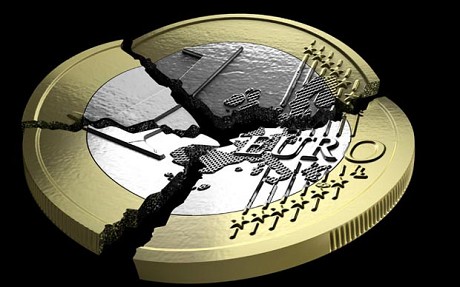
By Valdas Samonis
The current Prime Minister Andrius Kubilius Government of Lithuania adopted a very ambitious (no IMF help even sought!) and a rather very harsh austerity modeled on the reigning traditional EU thinking in order to clean the Augean stable of Lithuania’s finance wrecked by the former Soviet nomenklatura hijacked governments that largely used “easy” EU money to place their cronies in plum jobs in LT and Brussels (to the exclusion of younger generation of course), “prikhvatize” real estate and keep it from any socially beneficial taxation, etc.
The Kubilius Government’s harsh austerity policies (the so called internal devaluation) cutting public sector wages, social expenditures (by about one third) and increasing some taxes, etc, in a national fiscal belt tightening (“diet”) that has probably been the steepest in recent memory globally. Predictably, the GDP collapse was horrible at some 20%. The LT people have been pretty much resigned to the fate, in a stark contrast to Greece.
Despite repeatedly proving the nation’s responsibility and sacrifice (investment) capabilities via austerity, etc, LT did not attract much European/Western direct investment so the productivity remained at low post-communist levels at the time when emerging Asia provides a stiff global competition.
Before they realized what is going on and who was robbing them, the Lithuanian people got clabbered by this new ambitious austerity policy and the younger ones started emigrating in catastrophic numbers, seeing no future in the country whose GDP was reduced (from a low post-Soviet level) by some 20% by the combination of the old nomenklatura rent-seeking policies and the continued global Great Recession. Lithuania is hollowing out, unfortunately.
While the Lithuanians made huge sacrifices and so “invested” in the future, the Greeks have been continuing the party here and now until the last bottle or perhaps they can get another one, and another :).
In the current state of European affairs, Greeks won, Lithuanians lost!
- Bookmark :
- Digg
- del.icio.us
- Stumbleupon
- Redit it
|
LITSHARES: |
|
A Strategy for Global Financing of Lithuania’s Development |
|
Dedicated to Those Dead or Alive Whose Blood and Brains Made Free Lithuania Possible |
|
|
|
By Valdas Samonis |
|
2/16/2012 |
|
ABSTRACT. Given the dangerous European and global economic and strategic predicaments, Lithuania (LT) needs to adopt very bold and innovative ways to “sell” to the world its extreme austerity sacrifices during the continuing period of global Great (D)Recession and its earlier periods of bold systemic transformations as well. This proposal is a new strategy to globalize LT financial-economic ties (optimal global integration) so that the nation is no longer badly cornered and unduly dependent on the moribund European Union (EU) which is distracted and disoriented by the cacophony of austerity/profligacy controversies, and actually rewarding free riders by default. By now it is rather clear that Europe alone cannot properly reward the financial virtue and sacrifice of the LT people for the sake of the future (investment) which is the most distinguishing trait of a responsible nation and a mature leadership; hence the need for LT to go before the entire “global village”. Globalization can provide huge and underappreciated benefits for a nation like LT. This litshares or litakcijos (LTS) proposal is still to be developed to a greater detail and “hands-on” policy relevance. In the first instance, LTS would appeal strongest to LT residents, diasporas, and other FOLK (Friends of Lithuania of All Kinds); then they would catch up globally rather fast. |
Introduction and Attributions
The basic insight which gave rise to my litshares (LTS) proposal for Lithuania (LT) stems from the Nobel level economist Robert J. Shiller who is the Arthur M. Okun Professor of Financial Economics at Yale University, USA, and the author of the forthcoming book entitled Finance and the Good Society (Princeton University Press) as well as the co-author (with Nobelist G. Akerlof) of my recently reviewed book Animal Spirits: How Human Psychology Drives the Economy and Why It Matters for Global Capitalism (Princeton University Press). I have gained a lot of inspiration and new understanding from my extensive discussions at The Institute for New Economic Thinking (INET), particularly interactions with the Reagan Era’s US Fed Chairman Paul Volcker and other top global experts at the INET Bretton Woods Conference in 2011. Research assistance by Ramune Samonis, University of Toronto, is gratefully acknowledged.
Right after the pinnacle of the disastrous financial crisis in 2008, The Queen Elizabeth II asked economists, “Why did no one see the credit crunch coming?” Three years later, a group of Harvard undergraduate students walked out of an introductory economics course and wrote, “Today, we are walking out of your class, Economics 101, in order to express our discontent with the bias inherent in this introductory economics course. We are deeply concerned about the way that this bias affects students, Harvard University, and our greater society.” What has happened? Rebellion from both above and below suggests that economists, who were recently at the core of power and social leadership in our society, are no longer trusted much. Not long ago, the principal theories of economics appeared to be the secular religion of society, writes Dr. Robert Johnson, Executive Director, The Institute for New Economic Thinking.
Nice Try, Europe!
Since 2007, in the five years of the continuing economic crisis, the European Union (EU) countries have been performing very badly: 22 of its 27 members incl. those from Central & Eastern Europe (CEE) have lost time as measured by several economic clocks (GDP levels, share prices, real estate values, etc). Asia has performed much more strongly but even it presents a mixed picture. In particular, the long road back for global shares as measured by the most important indices according to data by Prof. R. Shiller, The Economist, and Thompson Reuters, see Chart 1.
Chart 1: The Long & Winding Road Back to Zero for Global Shares

The theory of economic integration was developed over half a century ago by Jan Tinbergen, Bela Balassa, and other prominent scholars of integration. However, the house of the European integration has been built on flawed fundamentals. While the European integration fathers (Schuman, etc) were understandably in a rush to rebuild Europe on a different model as quickly as possible so it avoids the repetition of the disastrous 20th Century wars, the art and science of “architecture” in building the European integration (United States of Europe) were not properly understood and used. Simply copying the USA does not work in Europe, as we abundantly know now. With these fundamental problems, the diagnosis and prognosis for Europe does not look good at all.
With the European Central Bank/euro acting as the "new" gold standard and the current totally confused austerity/profligacy debates, Europe is probably repeating the most horrible mistakes of the bloody past. In the 1920s, after experiences of inflation and then huge and uncontrolled capital inflows, Germany lost productivity advantages in part due to uncontrolled wage growth in the environment of heavy leftist/communist propaganda. Capital inflows suddenly turned to a trickle, governments and banks were squeezed for money and credit, bank asset fire sales started, followed by runs on banks, deflation, Great Depression; the rest is history. Under the regime of the fixed exchange rates of the gold standard, this history was the logical outcome. John M, Keynes wrote in his book The Economic Consequences of the Peace back in 1919:
“Very few of us realize with conviction the intensely unusual, unstable, complicated, unreliable, temporary nature of the economic organization by which Western Europe has lived for the last half century. We assume some of the most peculiar and temporary of our late advantages as natural, permanent, and to be depended on, and we lay our plans accordingly. On this sandy and false foundation we scheme for social improvement and dress our political platforms, pursue our animosities and particular ambitions, and feel ourselves with enough margin in hand to foster, not assuage, civil conflict in the European family”.
Since 2000, the risks are even worse because of toxic assets (mortgage backed securities, other derivatives, etc) that spread around the world in and nobody knows the true financial health position of counterparties. In the near European future, we are likely to see similar credit crunch spasms, catastrophic collapses of exports/trade, and Europe's Great Depression 2: economic and political disintegration, beggar-thy-neighbor policies, conflicts, etc. The history does not repeat itself exactly though.
The USA may follow the unenviable example of Japan but at least that is a slow and gradual decline that gives opportunities for new bursts of the US "animal spirits" and new turnarounds, e.g. via increased immigration, new and exports-oriented manufacturing technologies, etc.
Without getting here into undue larger debates, it is sufficient to sum up that conventional European approaches fail to provide remedies to the great majority of the economic Greek Tragedies that afflicted the continent and the world, incl. the current Great (D)Recession; this rather sweeping assertion is not even controversial in early 2012. The reason it is so is that these standard economic theory approaches completely fail to account for the operation of “animal spirits”, a concept dating back to John M. Keynes. Animal spirits are our interpretations of finance, economics and the economy, our mental/psychological forces and constructs, spiritus animalis from the original Latin. They include: (non)confidence (with its Keynesian style multipliers), the issue of fairness in wage determination and other areas (like comparative pensions among nations), corruption and bad faith phenomena in the societies, money illusion that people usually operate under, and stories that are our practical and simplified ways of thinking about our economic and financial affairs.
Enter the Center: Lithuania
Located at the geographical center of Europe, Lithuania has been leading the postcommunist world in economic and political reforms, shedding development retarding legacies of the occupying power (USSR), and trying to re-join the global village after some half a century of the Soviet occupation and the resultant destruction of ties to the world. Since 1990 Declaration of Independence, LT has gained a unique global recognition, even admiration, for its valiant and peaceful freedom-seeking anticommunist revolution and thus amassed a lot of global political capital and global good will. In the interwar independence period that included the global Great Depression, LT had a second strongest currency in Europe, after the Swiss franc. The problem is that LT remains a very timid seller of its stamina, achievements, etc, seemingly resigned to sacrifices without getting much credit for them in this global village of ours.
Since the Annus Mirabilis 1989, the theory was that Central and Eastern Europe (CEE) would use its abundant and (relatively) educated labor force to grow faster and on a more sustainable and consumer-oriented (prosperity) basis due to a decisive shift to markets and European integration. The EU integration was supposed to anchor market reform achievements and help secure new sustainable growth as outlined in the now almost forgotten EU Growth and Stability Pact.
What got in the way is the theory of (rational?) expectations?
True, CEE did receive a sort of a very modest version of Marshall Plan from the EU. True to four EU freedoms, Western Europe has been opening in fits and starts to labor movements (emigration) from CEE. So when new CEE policymakers were implementing pretty liberal market reforms, they should have anticipated some outflows of labor force to much higher bidders in Western Europe due to simple demonstration effect. Poorly understood legacies of communism are at fault here.
What got in the way is the law of unintended consequences in complex processes?
When the British opened their labor markets to the East, they anticipated some 10-12 thousand immigrants from Poland, for example, what they got is some one million and rising. Who knows what the figure will be a longer time after Germany’s opening in 2011?
What got in the way is the paradigm of hard-to-calculate policy externalities?
The current Prime Minister Andrius Kubilius Government of Lithuania adopted a very ambitious (no IMF help even sought!) and a rather very harsh austerity modeled on the reigning traditional EU thinking in order to clean the Augean stable of Lithuania’s finance wrecked by the former Soviet nomenklatura hijacked governments that largely used “easy” EU money to place their cronies in plum jobs in LT and Brussels (to the exclusion of younger generation of course), “prikhvatize” real estate and keep it from any socially beneficial taxation, etc. The Kubilius Government’s harsh austerity policies (the so called internal devaluation) cutting public sector wages, social expenditures (by about one third) and increasing some taxes, etc, in a national fiscal belt tightening (“diet”) that has probably been the steepest in recent memory globally. Predictably, the GDP collapse was horrible at some 20%. The LT people have been pretty much resigned to the fate, in a stark contrast to Greece.
The Kubilius Government has been operating under the handicap of the currency board (CB) arrangement which is an alternative monetary arrangement to a central bank and a national monetary policy, e.g. using short-term interest rates. Against a better advice, CB was introduced as far back as 1994, even though LT has had very good interwar comparative experiences with running the second strongest currency of Europe in a classical central bank formula that fits the responsible nation like LT very well. As opposed to the classical central bank, CB allowed no room for monetary easing while doing harsh austerity. For all practical reasons, LT currency has been hard pegged to euro resulting in a quasi Eurozone membership of LT. The formal LT membership of the Eurozone was denied by Brussels on the flimsy grounds of miniscule short-term inflation targeting problems, while France and other Eurozone core countries have been rather openly violating the EU’s fundamental Maastricht Treaty and the Growth and Stability Pact. As we know from the world history (e.g. Argentina), CB regimes can be very destabilizing (incl. runs on banks, etc) during the kind of deep turmoil periods that Europe is experiencing since 2008.
Despite repeatedly proving the nation’s responsibility and sacrifice (investment) capabilities via austerity, etc, LT did not attract much European/Western direct investment so the productivity remained at low postcommunist levels at the time when emerging Asia provides a stiff global competition.
Thus, very unlikely EU countries, like the Soviet communist exploited and impoverished Lithuania, have long showed the way to Europe by adopting serious austerity policies that go almost to the point of "eating the dog food", to use a hyperbole. Unfortunately, this good model that Europe has been looking so desperately for (and could not find) is drowned in the cacophony of bureaucratic quarrels around bailing out Greece and other profligate countries that are, so far at least, the true winners in Europe. Theoretically, if the nation like LT adopts a conventional, hard austerity policy, a serious “diet” designed to improve public finances and the resultant “crowding out effect”, the nation should get into the global position of substantially improved financial reputation, presumably also the much lower cost of its longer-term capital.
However, it all comes to empirics and experiential learning. Theoretically, you can think of a hypothetic success story of "expansionary austerity". It would be due to the removal or reduction of the crowding out effect (COE) that government profligacy usually causes. The removal of COE should theoretically lead to productivity increases on the strength of the argument that business can innovate/do business better than government does; vide long economic history of postcommunist countries and of the world in general. However, the problem is the time horizon. If austerity leads to the catastrophic collapse of GDP, then emigration of hard-to-replace human resources and capital flight usually follow. In short, austerity can work in the long run provided that the long run exists at all; that is if the economy is not dead by that time, to paraphrase Keynes. Ultimately, economic policy is about experiential learning, empirics that are. When a nation’s economy contracts, as LT did by some 20%, and its debt continues to grow, a big problem develops for the taxpayers. This is why Europe is in turmoil right now. “Expansionary austerity” is an oxymoron, every bit as it sounds, in the mid-term at the very least.
Before they realized what is going on and who was robbing them, the Lithuanian people got clabbered by this new ambitious austerity policy and the younger ones started emigrating in catastrophic numbers, seeing no future in the country whose GDP was reduced (from a low post-Soviet level) by some 20% by the combination of the old nomenklatura rent-seeking policies and the continued global Great Recession. Lithuania is hollowing out, unfortunately.
While the Lithuanians made huge sacrifices and so “invested” in the future, the Greeks have been continuing the party here and now until the last bottle or perhaps they can get another one, and another:).
In the current state of European affairs, Greeks won, Lithuanians lost! This is the tale of two integrating nations: they are even related since ancient times according to a Greek Palemonas legend.
Litshares: The Conceptual-Analytical Framework for Globalizing Lithuania
Despite some serious problems with the first stage of globalization, it can provide huge and so far very poorly understood benefits for a responsible, thousand-year nation like LT. How about developing an innovative strategy to get some hard earned respect and actual long-term financial capital for sustainable development of LT from the global markets? Below is my proposed case for litshares or litakcijos (LTS) for LT.
Writing in the Harvard Business Review (HBR, January-February 2012), Prof. Robert Shiller suggested a simplifying assumption that a nation can be treated as a corporation from an investment and developmental point of view. Corporations use both debt and equity to finance their investments and operations; nations use only debt.
The logic goes that nations like LT should replace much of their existing national debt with shares in the “earnings” of their economies. This would allow them to better manage their financial obligations, present themselves better before global markets, and could help prevent future financial crises. It might even lower a nation’s borrowing costs in the longer run. LT paid something like 10% as a cost of capital in the recent past, usury really.
National shares would function much like corporate shares traded on stock exchanges of the world: London, Frankfurt, NYC, Hong Kong, Toronto, etc in the case of LTS. They would pay dividends regularly. Ideally, they would be in perpetuity, although a nation could always buy its shares back on the open market. The price of a share would fluctuate from day to day as new knowledge about a nation’s economy came out and have been digested by global analysts. The opportunity to participate in the uncertain economic growth of the new issuer nation (esp. “hidden gem” like LT) might excite investors, just as it does in the stock markets around the world.
Helped by Dr. Mark Kamstra, Prof. Shiller developed some insights on how these new national shares could work. In my proposed case of LT, these litshares (LTS) could pay a quarterly dividend equal to exactly one-billionth of the nation’s quarterly GDP (some 30 billion LTL in Q4, 2011), the simplest measure of national earnings. The fractional value of LTS could be different of course; but the important consideration in case of LT is to attract all the global investors, even smaller ones. The payoff would vary of course, depending on how well the nation like LT does, what the GDP growth is (over 100 billion LTL in 2011). If the economy surprised the investors on the upside, dividends would go up; if it declined, dividends would fall. The global markets would determine the price of an LTS which would be normally volatile. It would depend not only on the most recent dividend but also on the investors’ expectations for the future, which can change for the better precisely because of austerity “investments” by LT or any other nation, as opposed to profligacy of other nations, etc. There is s some evidence that a LTS might often be expensive relative to the dividend, which would be good for the national issuer. Prof. Shiller observes that shares of many US corporations and 10-year US Treasury notes sell for over 50 times their annual dividend. Since the growth rate of the real US GDP has been higher than that of real S&P 500 earnings in the past (3.1% annual GDP growth versus 2.5% annual S&P 500 growth over the past half century), such shares might sell for a multiple higher than 50.
Litshares Could Be Attractive Investments Globally
The advantage of keeping LTS equal to a billionth part of the economy is that people will know exactly what they are getting: one-billionth of a thousand-year old nation like LT is real and easy to understand for global investors. Such shares based on GDP have the great merit of being really clear, simple, and understandable to investors globally. Other measures of national earnings might seem to some analysts more appropriate than GDP but would sacrifice the great virtue of simplicity, clarity, transparency. This kind of simplicity and clarity encourages the development of badly needed confidence and trust that governments will not shirk their obligations at any time in the future. This is much better confidence and trust building strategy than any heavily advertised “magic” mechanisms like currency board that LT adopted against a better advice back in 1994.
LTS may appeal to international investors even more than corporate shares do because LTS would avoid the problem of the so called moral hazard. Here is the reason that Prof. Shiller stresses. If international investors ever acquired a good fraction of a nation’s corporate shares, the nation would have an incentive to raise the corporate profit tax on those shares or regulate them to reduce their value. If a nation did so, like the Kubilius Government rather erroneously did in LT, it would benefit without technically violating any promises. The issuance of LTS, however, would involve a strong and easily understandable promise of share in the value added (GDP) to global investors. If the shares paid dividends in the nation’s domestic currency like LTL, it would eliminate another moral hazard associated with the traditional debt. If the national shares strategy is adopted, the nation could not reduce its real obligations by creating inflation (e.g. via devaluation, as is already happening in some CEE countries), as they can with conventional government debt, because their nominal GDP would increase in proportion to the inflation thus created.
Speaking of Greece, Prof. Shiller asks what effect could national shares have had during the Great Recession and its aftermath? Greece’s real GDP fell 7.4% in 2010. If its shares were leveraged substantially, e.g. five to one, then the dividend paid on them would have fallen by about 40%. This would have done much to alleviate the crisis, making it easier for notoriously rebellious Greek taxpayers to bear. It would have given Greece a bailout without any scandal-ridden international controversies, loss of face and reputation or broken promises. After the fact, investors in Greek national shares would have been unhappy. But they still might have been willing to buy them, considering the very possible upside of such a leveraged investment. Global investors eagerly buy leveraged corporate stocks, so it is plausible that they would buy leveraged national shares as well. Global markets for national shares would fundamentally change the economic atmosphere (and confidence) in a nation like Greece or LT. An immediate market response would accompany every new governmental plan (strategy) affecting the future of the economy and society, generating discussions, free publicity, and a broader knowledge of each nation’s development plans, as well as much more energetic flows of global resources towards nations with plans that passed the transparent global markets test. This is much simpler and easier to understand for investors than the obscure and at times obviously disreputable work of traditional credit rating agencies or corrupt analysts.
In Lieu of Conclusions
With national share prices going up and down, LTS or other such shares might look to some analysts as an unwelcome extension of financial capitalism. Financial industry is in deep disrepute globally for causing this Great (D)Recession. But, in fact, the thoughtful implementation of disciplined financial capitalism has been the story of every successful nation in history. LT has made a very good headway. We should have real global markets for nations like LT; such “macro” markets would track their successes much more accurately and justly than stock markets usually do. And LTS would do the necessary justice to serious efforts and results of structural reforms and financial discipline like in LT. Stock markets trade only in claims on corporate earnings after corporate taxes, which is an unreliable measure of a nation’s success. We can do better, concludes Prof. Robert J. Shiller who was among the very few experts to have predicted this Global (D)Recession. He argues that, rather than condemning finance, we need to reclaim it for the common good. He makes a powerful case for recognizing that finance is one of the most powerful tools we have for solving our common problems as mankind, and increasing the general well-being of people. We need more financial innovation and more globalization that would be developed in the policy environment of proper risk and knowledge management. The acute need for modern risk/knowledge management arises because global markets do an excellent job of nurturing financial innovations that people want (rather than need); but they are much less useful for planning for when things go wrong, like in this Global (D)Recession.
With regard to my LTS proposal, in the first instance, LTS would appeal strongest to LT residents, diasporas, and other FOLK (Friends of Lithuania of All Kinds); then they would catch up globally rather fast. My LTS proposal is to be developed to a much greater detail and “hands-on” policy relevance.
Valdas Samonis
INET and SEMI Online
Toronto-New York City-Vilnius
For more on V. Samonis publications, please consult:
V. Samonis Author Page on Amazon.com
http://www.amazon.com/Valdas-Samonis/e/B0031SF300/ref=ntt_dp_epwbk_0
and/or search for the name Samonis (Val or Valdas) in Google.com.

- Bookmark :
- Digg
- del.icio.us
- Stumbleupon
- Redit it
Lithuania is a cultural treasure the world still knows far too little about
- Posted by - (3) Comment
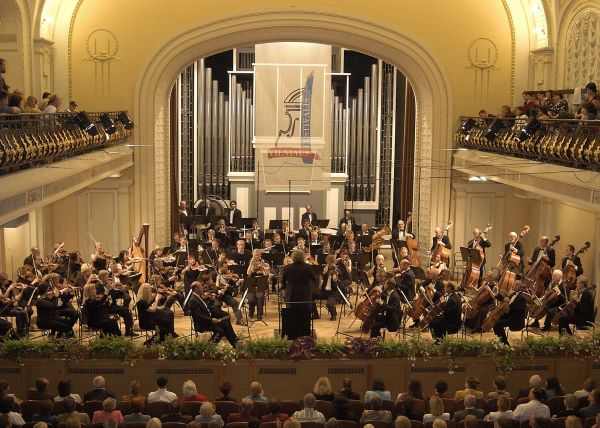
The Lithuania National Symphony Orchestra playing in the National Philharmonic Hall, Vilnius.
Conductor: Professor Juozas Domorkas. Photo: Michailo Raškovskio
Far too few people outside Lithuania know what a tremendous treasure of culture this country represents! Today Lithuanian art is not only flourishing at home but is also gaining recognition internationally. Though not every poster tells that a nightingale soprano, a graceful ballerina, or a divine cello player comes from Lithuania, the probability that you have just enjoyed a concert of a Lithuanian artist is great, whether it be New York, London, Berlin, or Vilnius.
Vilnius, a city with a population slightly more than half a million, is packed with art galleries and is full of posters inviting you to exhibitions, concerts and plays, both in traditional galleries and concert halls, but also in less traditional venues. The old town itself is like a spacious and cosy gallery of Baroque architecture.
And it is not only Vilnius that can boast of a rich cultural life. Nearly every bigger town has a professional theatre, concert hall and a tradition of regularly attending cultural events. Though the Lithuanian summer is short, the summer calendar is packed with festivals going on all around Lithuania.
For centuries Lithuania has been home to those of Slavic, Jewish, Karaite, and Prussian descent, along with those of other nations. This multiculturalism, along with the figurative expression in literature, theatre, cinema and fine arts, has become a hallmark of Lithuanian art. The link between history and the present is the feature pointed out most often by lovers of Lithuanian art in neighbouring European countries and more distant Asian countries...
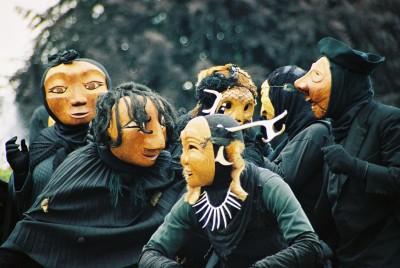
“Užgavėnės” is a Lithuanian festivalthat takes place during the seventh week before Easter (Ash Wednesday). Its name in English means “the time before Lent”. The celebration corresponds to Roman Catholic holiday traditions in other parts of the world, such as Mardi Gras, Shrove Tuesday, and Carneval.
Europe is discovering Lithuania through its culture. Lithuanian art is not only flourishing in Lithuania but is also gaining recognition internationally. Though not every poster tells that a nightingale soprano, a graceful ballerina, or a divine cello player comes from Lithuania, the probability that you have just enjoyed a concert of a Lithuanian artist is great, whether it be New York, London, Berlin, or Vilnius.
Vilnius, a city with a population slightly more than half a million, is packed with art galleries and is full of posters inviting you to exhibitions, concerts and plays, both in traditional galleries and concert halls, but also in less traditional venues. The old town itself is like a spacious and cozy gallery of Baroque architecture.
It is not only Vilnius that can boast of a rich cultural life, but nearly every bigger town has a professional theatre, concert hall and a tradition of regularly attending cultural events. Though the Lithuanian summer is short, the summer calendar is packed with festivals going on all around Lithuania.
For centuries Lithuania has been home to those of Slavic, Jewish, Karaite, and Prussian descent, along with those of other nations. This multiculturalism, along with the figurative expression in literature, theatre, cinema and fine arts, has become a hallmark of Lithuanian art. The link between history and the present is the feature pointed out most often by lovers of Lithuanian art in neighboring European countries and more distant Asian countries. They also point to the tolerance and openness of Lithuania culture towards cultures of other nations.
Literature
Lithuanians are well-read nation. Enthusiastic participation in international book fairs has changed the attitude of foreign publishers towards Lithuanians writers and also of Lithuanians themselves. Earlier the leading role in Lithuanian literature was played by poetry, though international book fairs brought a revelation that should show more interest in and be proud of the modern prose by talented Lithuanian women writers like Jurga Ivanauskaitė, Renata Šerelytė, Vanda Juknaitė and gifted contemporary authors such as Sigitas Parulskis and Marius Ivaškevičius. The most pleasing fact is that despite global computerization, both translations and books by Lithuanian authors still top gift lists, and that the Baltic book fair in Vilnius is attended by nearly every second Lithuanian family.
Theatre
Meanwhile Lithuanian theatre could be called the most intriguing part of the general development of theatre happening worldwide. Moreover, stage directors from Lithuania have a huge following in many parts of the world: Eimuntas Nekrošius is a favorite of Italian drama ad opera theatres, Rimas Tuminas is beloved in the Nordic countries, and the festivals in Avignon and Edinburgh cannot be imagined without Oskaras Koršunovas. Lithuanian theatre performances are always a big event in Russia, and the number of Lithuanian theatre fans is rapidly growing in France, Germany, Italy, Spain, South Korea, Hong Kong, USA, Mexico, Canada, Columbia, Argentina and Brazil.
Opera star Violeta Urmana performs at famous theatres and concert halls all over the world, but few know that this top level soprano is Lithuanian. Similarly successful are other Lithuanian musicians, traveling and performing in concert halls all over the world, and winning awards at international festivals. They are performing not only popular or modern world classics, but also the music by famous Lithuanian composers – Onutė Narbutaitė, Raminta Šerkšnytė, Bronius Kutavičius, Osvaldas Balakauskas, Algirdas Martinaitis, Mindaugas Urbaitis and Anatolijus Šenderovas.
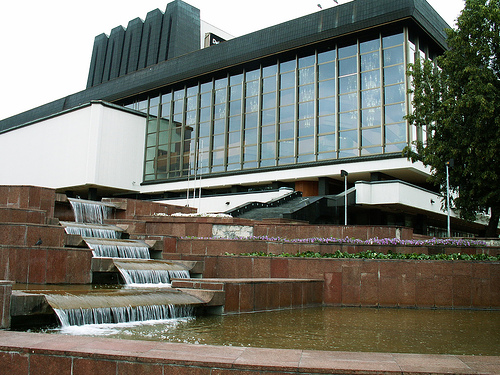
The Lithuanian National Opera and Ballet Theatre invites you to the performance of the 2011 Season . Keeping in mind that all tickets are usually sold out before the performance, we recommend you to book tickets beforehand.
Fine arts
Today exhibition halls show the pieces of fine arts painted a few decades ago, and which is referred to as „silent modernism“. It contributed to the maturity of the artists of the modern generation who freely communicate with the audience through their installations, performances and video art not only in the Contemporary Art Center in Vilnius, but also in Paris, Venice and New York. Pieces of art by Eglė Rakauskaitė, Paulius and Svajonė Stanikas, Deimantas Narkevičius, and Gediminas and Nomeda Urbonas, which have reached international audiences, provided a possibility for Lithuanians themselves to realize the unique nature of their art.
Every encyclopedia or reference book on art has an entry about Fluxus. But few of them mention that this influential movement was initiated by Lithuanian Jurgis Mačiūnas.
Who is Jurgis MAČIŪNAS?
Jurgis Mačiūnas, internationally known as George Maciunas, the father of Fluxus, (November 8, 1931- May 9, 1978) was born in Kaunas, Lithuania. As a young man he moved to Germany to escape the Soviet occupation of Lithuania.
What is FLUXUS?
Fluxus (from „to flow“) is an art movement noted for the blending of different artistic disciplines, primarily visual art, but also music and literature.
Fluxus included a strong current of anti-commercialism disparaging the conventional market-driven art world in favor of an artist-centered creative practice.
Among its early associates were Joseph Beuys, Dick Higgins, Nam June Paik and Yoko Ono.
Fluxus has also been compared to Dada and aspects of Pop Art and is seen as the starting point of mail art.
Paintings by Dalia Kasčiūnaitė, Ričardas Vaitiekūnas, Rūta Katiliūtė, Algis Griškevičius, Vilmantas Marcinkevičius, slupture Mindaugas Navakas, and many others are exquisite pieces in many foreign, private and even royal collections of art.
Cinema
Though Lithuanian cinema directors are yet not as known as Danish, French or Italian masters, they still have their audience, who appreciate Lithuanian cinema for deep insight into the human being and its poetic view towards life. Lithuanian short films by Giedrė Beinoriūtė, Ramūnas Greičius, Inesa Kurklietytė and documentaries by Audrius Stonys, Valdas Navasaitis and Arūnas Matelis have garnered international awards and numerous international film festivals.
Lithuanian films have also found their audience in Cannes, New York, Tokyo with cinema fans having already gotten acquainted with the names of Šarūnas Bartas, Algimantas Puipa, Janina Lapinskaitė and Kristijonas Vildžiūnas.
Jonas Mekas (born December 23, 1922 in the village of Semeniškiai) is a Lithuanian filmmaker, writer, and curator who has often been called “the godfather of American avant-garde cinema”. He was the founder of the Anthology Film Archives, The Film Makers Cooperative and Film Culture magazine. He wrote film reviews for The Village Voice since 1958. He was heavily involved with artists such as Andy Warhol, Nico, Yoko Ono, John Lennon, Salvador Dali and fellow Lithuanian George Maciunas.
During WWII, Mekas lived in displaced persons camps before emigrating to the United States with his brother, Adolfas Mekas, in 1949.
Though his narrative films and documentaries are still highly regarded, he is best known for his diary films, such as Walden (1969), Lost, Lost, Lost (1975), Reminiscences of a Voyage to Lithuania (1972), and Zefiro Torna (1992). In 2001, he released a five-hour long diary film entitled As I Was Moving Ahead, Occasionally I Saw Brief Glimpses of Beauty, assembled by hand from an archive of fifty years worth of recordings of his life.
He is also a highly regarded poet in Lithuania.
Whatever it is – a movie, a book presentation or a theatre performance – the label “LITHUANIA” means an opportunity to experience and universally enriching.
Source: http://lietuva.lt/en/culture

The painting “Harvest Girl” (Pjovėja) from 1844 by Kanutas Ruseckas (1800-1860) is probably the most popular painting in the Vilnius Picture Gallery - Lietuvos dailės muziejos.
- Bookmark :
- Digg
- del.icio.us
- Stumbleupon
- Redit it
- Posted by - (0) Comment
Frankfurter Rundschau:
”Lukaschenko, der gnadenlose Barbar”
Lukashenko, the
ruthless barbarian
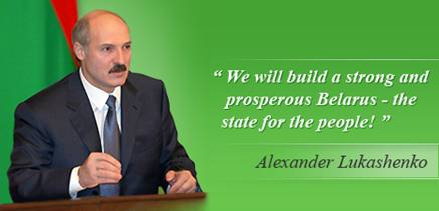
Photo/motto: http://president.gov.by/en/
German newspaper Frankfurter Rundschau calls Belarusian President Alexander Lukashenko a ruthless barbarian after the execution of two young men convicted of a bomb attack at Minsk subway’s most crowded station on April 11, 2011
"The question of whether the guilty of the convicted has been proven is not decisive. The president, who believes that the death of people can be repaid by the death of others, makes a killer of himself. Disregard for human life makes them indistinguishable,” writes the newspaper.
“In addition,” says the newspaper, “the method of the execution in Minsk - a shot in the head - is a symbol of terror in itself. For example, that was the way of killing of thousands of Stalin's victims by monstrous hangman Vasili Blokhin. The memory of this is embodied in the collective consciousness in the former Soviet space deeper than it’s portrayed in the West."
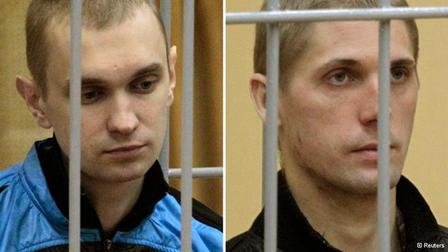
Last November, Dmitry Konovalov and Vladislav Kovalyov were convicted of a bomb attack at Minsk subway’s most crowded station on April 11, 2011, which killed 15 people and wounded hundreds of others. Last Friday they were both executed, shot in their necks.
- Bookmark :
- Digg
- del.icio.us
- Stumbleupon
- Redit it
- Posted by - (1) Comment
Frankfurter Rundschau:
”Lukaschenko, der gnadenlose Barbar”
Lukashenko, the
ruthless barbarian

Photo/motto: http://president.gov.by/en/
German newspaper Frankfurter Rundschau calls Belarusian President Alexander Lukashenko a ruthless barbarian after the execution of two young men convicted of a bomb attack at Minsk subway’s most crowded station on April 11, 2011
"The question of whether the guilty of the convicted has been proven is not decisive. The president, who believes that the death of people can be repaid by the death of others, makes a killer of himself. Disregard for human life makes them indistinguishable,” writes the newspaper.
“In addition,” says the newspaper, “the method of the execution in Minsk - a shot in the head - is a symbol of terror in itself. For example, that was the way of killing of thousands of Stalin's victims by monstrous hangman Vasili Blokhin. The memory of this is embodied in the collective consciousness in the former Soviet space deeper than it’s portrayed in the West."

Last November, Dmitry Konovalov and Vladislav Kovalyov were convicted of a bomb attack at Minsk
subway’s most crowded station on April 11, 2011, which killed 15 people and wounded hundreds of others.
Last Friday they were both executed, shot in their necks.
Frankfurter Allgemeine Zeitung goes on with the subject, saying:
"The death sentence was most likely decided just two days after the attack, when Lukashenko announced that the criminals had been detained. The president decides, not the courts. The same thing is happening in Belarus in all other aspects - the “truth” of the president is what counts. If the reality dares to deviate from this truth, there are always other people to blame and they should pay for it.
Nobody knows who is really behind the explosion in Minsk subway, as it’s been poorly investigated, and, obviously, will remain a mystery forever. One thing is clear, however; the dictatorship, not knowing the difference between the establishment of the truth in court and violence is a danger to society."
The newspaper Tageszeitung writes:
"Tamara Chikunova from Uzbekistan and Lubov Kovalevs from Belarus suffered a lot: their sons were executed by a dictatorial regime. Both have fought and continue to fight for the honour of their sons and against the death penalty. Seven years after the execution of Chikunova’s son Uzbek government abolished the death penalty. This is a success, which would have been impossible without the efforts of the mother of the executed.
In Belarus, more and more people are rejecting the death penalty. Many residents of Minsk not only commemorated the victims of terrorist attacks last week, but also demanded the abolition of the capital punishment in Belarus. It’s time for civil society to act. One should support the forces that are fighting in the country against the death penalty.
But politicians must take certain steps, too. Minister of Foreign Affairs of the Netherlands, the second largest trade partner of Belarus, after Russia, Uri Rosenthal demanded the expansion of sanctions "against Europe's last dictator" in connection with the recent executions. Let’s hope that the suggestion of Rosenthal will be supported among colleagues."
The paper Die Welt analyzes the relationship of Moscow to Minsk and sees the penalty as a slap on the ear of the West.
Russia plays a murky role in this story: it is distancing itself from the Belarus regime, which is considered “bad” but is unwilling to let Belarus drift toward the West. The fact, that Lukashenko is burning bridges with the West, is not considered a great loss in Moscow. The country is now dependent on Russian aid because of its post-Soviet mismanagement.
The West tried to make a deal - dollars and euros in exchange for democratic reforms. It all was in vain: the dictator is only concerned about his own and his minions’ well-being. The lives of his nine million countrymen are of less importance.
- Bookmark :
- Digg
- del.icio.us
- Stumbleupon
- Redit it
- Posted by - (0) Comment
UŽUPIS SPRING 2012
Slide show with music. Full screeen recommended!
Photos: Aage Myhre
Director: Cassandra Myhre
Music: Music: Sergey Kuryokhin –
Morning Exercises in the Nuthouse
Užupis is a neighbourhood located in the outskirts of Vilnius' Old Town. Užupis means "on the other side of the river" in Lithuanian language and refers to the Vilnia River. The name Vilnius was derived from the Vilnia. Užupis is popular with artists, and has been compared to Montmartre in Paris due to its bohemian atmosphere. The district houses art galleries, artists' workshops, and cafés. On April Fools Day in 1997, the district declared itself an independent republic (The Republic of Užupis), replete with an army of 12 personnel. Užupis is largely characterized by dilapidated buildings, courtyards and cobblestone streets that haven‘t been renovated for decades. But when the music reverberates over the cobbles in the late evenings you will certainly fall in love with this unique part of Vilnius. The atmosphere – filled with love, music, smells and happy people – will certainly catch your soul…
- Bookmark :
- Digg
- del.icio.us
- Stumbleupon
- Redit it
- Posted by - (0) Comment
“Give us this day our
daily harbour seal”
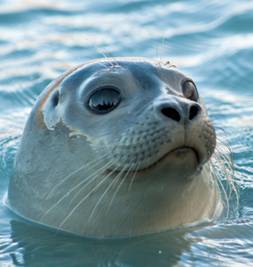 The harbour seal is found along temperate and Arctic marine coastlines of the Northern Hemisphere. |
 Hans Egede (1686 – 1758) was a Norwegian missionary, known as the Apostle of Greenland. |
Many of us remember our Lord’s Prayer, or Pater Noster as many call the most outstanding prayer of Christianity. One phrase goes as follows: “Give us this day our daily bread,..” This became an ever so slight nut to crack for the North Norwegian priest Hans Egede when he came to Greenland to preach in the 1700s. The indigenous people who populated the world's largest island, the Inuits, did not know what bread was!
But the priest found a solution, and in his translation to Inuit language the phrase became therefore logically enough, "Give us this day our daily harbour seal." Because it was these seals that were the most important element of the Inuit food chain at the time...
It was Hans Egede, often called the Apostle of Greenland, who founded the town of Nuuk (Godthåb), capital of today's Greenland. His statue stands solidly on its base in the outskirts of the town.
Nuuk (Godthåb), the capital of Greenland, offers colourful architecture where the winter bites as coldest
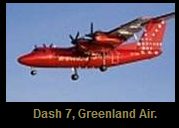 I sit at Kastrup Airport near Copenhagen, Denmark, an early February morning. Waiting to border the Scandinavian Airlines flight to Kangerlussuaq Airport in Greenland. Then comes the message: The flight is cancelled. Luckily I get on a plane from Greenland Air, and a couple of hours later I am sitting in a red Boeing 757 heading northwest. I have been awarded a seat between two mildly said overweight Inuits, Eskimoes as we used to call them in the past. It smells of sweat and I am unable to find room for my arms on the armrests. After four and a half hour of torment we land in the icy wilderness. The temperature outsideis -40C, inside the terminal building it is a little warmer. But not much.So I'm very happy when I finally, after several hours waiting time, get on board a red propeller plane, a Dash 7, flying me to Greenland's capital Nuuk further south on the island. The trip takes only an hour.
I sit at Kastrup Airport near Copenhagen, Denmark, an early February morning. Waiting to border the Scandinavian Airlines flight to Kangerlussuaq Airport in Greenland. Then comes the message: The flight is cancelled. Luckily I get on a plane from Greenland Air, and a couple of hours later I am sitting in a red Boeing 757 heading northwest. I have been awarded a seat between two mildly said overweight Inuits, Eskimoes as we used to call them in the past. It smells of sweat and I am unable to find room for my arms on the armrests. After four and a half hour of torment we land in the icy wilderness. The temperature outsideis -40C, inside the terminal building it is a little warmer. But not much.So I'm very happy when I finally, after several hours waiting time, get on board a red propeller plane, a Dash 7, flying me to Greenland's capital Nuuk further south on the island. The trip takes only an hour.
- Bookmark :
- Digg
- del.icio.us
- Stumbleupon
- Redit it
- Posted by - (1) Comment
“Give us this day our
daily harbour seal”
 The harbour seal is found along temperate and Arctic marine coastlines of the Northern Hemisphere. |
 Hans Egede (1686 – 1758) was a Norwegian missionary, known as the Apostle of Greenland. |
Many of us remember our Lord’s Prayer, or Pater Noster as many call the most outstanding prayer of Christianity. One phrase goes as follows: “Give us this day our daily bread,..” This became an ever so slight nut to crack for the North Norwegian priest Hans Egede when he came to Greenland to preach in the 1700s. The indigenous people who populated the world's largest island, the Inuits, did not know what bread was!
But the priest found a solution, and in his translation to Inuit language the phrase became therefore logically enough, "Give us this day our daily harbour seal." Because it was these seals that were the most important element of the Inuit food chain at the time...
It was Hans Egede, often called the Apostle of Greenland, who founded the town of Nuuk (Godthåb), capital of today's Greenland. His statue stands solidly on its base in the outskirts of the town.
Nuuk (Godthåb), the capital of Greenland, offers colourful architecture where the winter bites as coldest
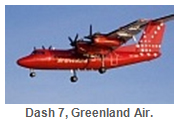 I sit at Kastrup Airport near Copenhagen, Denmark, an early February morning. Waiting to border the Scandinavian Airlines flight to Kangerlussuaq Airport in Greenland. Then comes the message: The flight is cancelled. Luckily I get on a plane from Greenland Air, and a couple of hours later I am sitting in a red Boeing 757 heading northwest. I have been awarded a seat between two mildly said overweight Inuits, Eskimoes as we used to call them in the past. It smells of sweat and I am unable to find room for my arms on the armrests. After four and a half hour of torment we land in the icy wilderness. The temperature outsideis -40C, inside the terminal building it is a little warmer. But not much.So I'm very happy when I finally, after several hours waiting time, get on board a red propeller plane, a Dash 7, flying me to Greenland's capital Nuuk further south on the island. The trip takes only an hour.
I sit at Kastrup Airport near Copenhagen, Denmark, an early February morning. Waiting to border the Scandinavian Airlines flight to Kangerlussuaq Airport in Greenland. Then comes the message: The flight is cancelled. Luckily I get on a plane from Greenland Air, and a couple of hours later I am sitting in a red Boeing 757 heading northwest. I have been awarded a seat between two mildly said overweight Inuits, Eskimoes as we used to call them in the past. It smells of sweat and I am unable to find room for my arms on the armrests. After four and a half hour of torment we land in the icy wilderness. The temperature outsideis -40C, inside the terminal building it is a little warmer. But not much.So I'm very happy when I finally, after several hours waiting time, get on board a red propeller plane, a Dash 7, flying me to Greenland's capital Nuuk further south on the island. The trip takes only an hour.
 I have come to Nuuk to monitor the construction of town-houses I had designed during the previous year from my architect office in Vilnius. I could hardly believe my ears when, a few months ago, I was told that the colours we should use was bright yellow, turquoise, pink and purple. All in pastel tones.
I have come to Nuuk to monitor the construction of town-houses I had designed during the previous year from my architect office in Vilnius. I could hardly believe my ears when, a few months ago, I was told that the colours we should use was bright yellow, turquoise, pink and purple. All in pastel tones.
Now I stand here in the bitter winter cold, watching the walls, manufactured in Lithuania, being lifted into place. I see that many of the houses around are also unusually colourful. Perhaps it is so that the colours give a little warmth in the otherwise barren, windswept winter landscape. Or is colour perception different for Inuits and other indigenous peoples than for us 'younger' versions of the human race?
The town of Nuuk is barely 300 years old, but this area has a long history of settlement, first occupied by the old pre-Inuits, the Paleo-Eskimos. Their Saqqaq culture dates as far back as 2200 BC when they lived in the area around a now abandoned settlement called Qoornoq. Over time the area was occupied by the so-called Dorset culture, which, however, disappeared from the Nuuk district, even before year 1000. The Norwegian Viking Erik the Red founded the first European settlements here, at the end of the 900s.The area was after that inhabited by the Vikings through a few hundred years. Inuits and Norwegians lived side by side until around 1500 when the Norse settlements ceased, probably due to changes in climate. It was also here the Viking ships sailed further west and came to Nova Scotia in today's America in the year 1000.
The Viking who led his armada of Viking ships to America was Leif Ericson. He came from a long line of explorers, and unfortunately murderers as well. Leif's great-great-great uncle, Nadod, discovered Iceland in about 861, and Leif's father, Erik Thorvaldson, otherwise known as Erik the Red, discovered Greenland around 970-980. After his father died, Erik moved to a different area of Iceland and got married. The next two incidents shaped the future. Erik himself was exiled and outlawed twice; the first time because his slaves caused a landslide that ruined a man's property. The second time, Erik attempted to get a family heirloom back, he and the men supporting this act, were attacked, and ended up murdering the man's sons and several of his supporters. So once again Erik was outlawed. Erik decided to venture out and explore during his three years of exile. It was during this time, about 970 A.D. that Leif was born to Erik the Red.
Leif's voyage to America was planned and had a forceful, brave, shrewd leader who was careful in all things. His discovery, then, was not an accident, as those who give too little credence to Viking navigational skills intimate. He set sail probably in 995, passed Markland (Labrador), and reached Newfoundland, where his thirsty crewmen drank dew from the grass. Here, in what probably was Leif's Vinland, the men decided to winter, noticing that the days were more equitable in length than at home in Greenland.
In addition to building lodgings, the men cut timber and hunted. Their tasks were eased by the fact that there were no natives in the vicinity. On one hunting and exploratory expedition, one Turk, who had lived in warmer climates, returned with grapes. Consequently the men began to cut vines and harvest grapes in addition to gathering timber. Because of the new find, Leif named the area Vinland, which subsequently became known as Vinland the Good. Where in Newfoundland Leif wintered is still a matter of controversy, but most leading scholars are firmly convinced that it was on that island. Grapes grew wild in quantity in Newfoundland until as late as the middle of the 17th century, because the climate then was much more benign than it is today.
This has been the story of a missionary who had to find a re-phrasing of the Lord's Prayer. It has also
been about a totally different colour understanding than what we are accustomed to, and it has been about Norwegian Vikings who more than 1000 years ago came to America, 500 years before Columbus 'discovered' the vast continent on the other side of the Atlantic Ocean.
Creativity, discovery urge, ability to survive and thrive even in harsh environments. This is what we can
learn from these people.
And in the midst of it all there are some colourful Lithuanian houses...
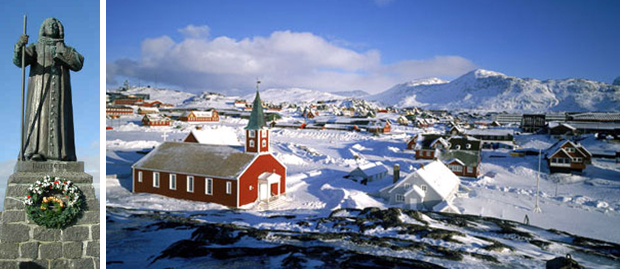
It was Hans Egede (1686-1758) who founded the town of Nuuk, Greenland's capital. But this is not exactly an overcrowded part of our world, so the population of the capital is still only around 15,000.
Photo: Cirrusnetwork.net
Aage Myhre, Editor-in-Chief
aage.myhre@VilNews.com
- Bookmark :
- Digg
- del.icio.us
- Stumbleupon
- Redit it
- Posted by - (0) Comment
Impacts of the new
Putin presidency on
U.S.-Russia relations?
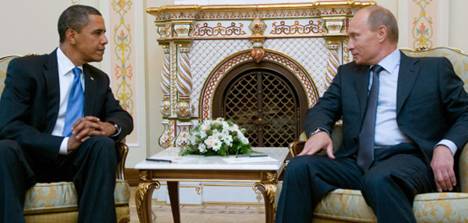
U.S. ties with Russia have been strained since Prime Minister Vladimir Putin began his re-election campaign for president. This has made it more difficult for Washington and Moscow to make progress on policy toward Syria and Iran, and we are in many fields now experiencing that the relatively warm contact between President Obama and President Medvedev is in the process of being replaced by a colder tone. Putin apparently prefers the role of counterweight more than being a world stage partner together with U.S.A.
This month marks three years since the U.S.- Russia “reset” was introduced. In March 2009, Secretary of State Hillary Clinton met with Russian Foreign Minister Sergei Lavrov in Geneva. They agreed that it was time to turn the page in relations between the two countries and start a constructive dialogue with a clean slate.
President Barack Obama has made better relations with Russia a cornerstone of his foreign policy . The so-called “reset” in relations with Russian President Dmitri Medvedev brought about a major arms-control agreement and increased cooperation on such issues as Afghanistan, Iran and Libya.
Analysts say there is currently a chill in relations between Washington and Moscow, not least due to Russia joining China in vetoing a U.N. resolution calling for Syrian president Bashar al-Assad to step aside. Secretary of State Hillary Clinton called the vote “a travesty.”
Georgetown University Russia expert Angela Stent says Vladimir Putin has been employing an old, familiar tool during his recent presidential campaign, blaming the United States for a lot of Russia’s problems..
“He has really resorted to a tactic that, of course, has been used since he became president in 2000 - and that is to invoke the United States [as the] enemy, to blame the United States for a lot of Russian problems," said Stent. "And as you saw, in the Duma elections, he then blamed Hillary Clinton, Secretary Clinton for supporting the opposition and for trying to undermine Russian stability.”
Russia expert Robert Legvold cites another example.
“When the new [U.S.] ambassador, Michael McFaul, hosted opposition figures, even though it was a quiet meeting, the authorities knew about it, had camera people there to film it," said Legvold. "And then that led the media, certainly at Putin’s behest, or media knowing what Putin would want, to sharply attack McFaul for doing this kind of thing, interfering and then accusing the opposition party of, through that channel, receiving funding from the United States.”
Mikhail Leontyev, a commentator on Russian state TV, said McFaul was close to U.S. intelligence services. Others have said McFaul has been sent to Moscow to foment an Orange Revolution in Russia.
The accusation that opposition leaders are working at the behest of the U.S. state department to generate an Orange-style revolution is an insult frequently levelled by Kremlin supporters.
"The thing is that McFaul is not a Russia specialist, but a specialist in a very specific kind of democracy promotion," Mr Leontyev said on Channel One's prime-time news programme.
Putin’s latest article, “Russia and the changing world ↑ ,” in Moskovskiye Novosti depicts the U.S. as a destabilizing and dangerous force on the world stage, which needs to be countered. Putin writes: “It seems that NATO members, especially the United States, have developed a peculiar interpretation of security that is different from ours. The Americans have become obsessed with the idea of becoming absolutely invulnerable….[this] is the root of the problem.”
In that article he rails against U.S. and NATO, alluding to the Arab Spring and support for the opposition in Syria, writing that justifications for military intervention in third-party states with the need to defend human rights is “not a noble cause,” but “elementary demagoguery.”
Given this anti-American rhetoric, questions are being raised as to what impact the new Putin presidency will have on U.S.- Russia relations.
U.S. Ambassador to Russia Michael McFaul: Introduction video
- Bookmark :
- Digg
- del.icio.us
- Stumbleupon
- Redit it
- Posted by - (1) Comment
Impacts of the new
Putin presidency on
U.S.-Russia relations?
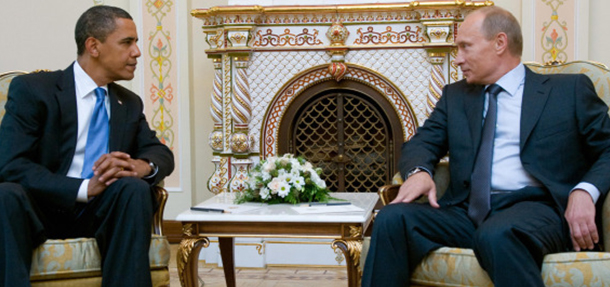
U.S. ties with Russia have been strained since Prime Minister Vladimir Putin began his re-election campaign for president. This has made it more difficult for Washington and Moscow to make progress on policy toward Syria and Iran, and we are in many fields now experiencing that the relatively warm contact between President Obama and President Medvedev is in the process of being replaced by a colder tone. Putin apparently prefers the role of counterweight more than being a world stage partner together with U.S.A.
This month marks three years since the U.S.- Russia “reset” was introduced. In March 2009, Secretary of State Hillary Clinton met with Russian Foreign Minister Sergei Lavrov in Geneva. They agreed that it was time to turn the page in relations between the two countries and start a constructive dialogue with a clean slate.
President Barack Obama has made better relations with Russia a cornerstone of his foreign policy . The so-called “reset” in relations with Russian President Dmitri Medvedev brought about a major arms-control agreement and increased cooperation on such issues as Afghanistan, Iran and Libya.
Analysts say there is currently a chill in relations between Washington and Moscow, not least due to Russia joining China in vetoing a U.N. resolution calling for Syrian president Bashar al-Assad to step aside. Secretary of State Hillary Clinton called the vote “a travesty.”
Georgetown University Russia expert Angela Stent says Vladimir Putin has been employing an old, familiar tool during his recent presidential campaign, blaming the United States for a lot of Russia’s problems..
“He has really resorted to a tactic that, of course, has been used since he became president in 2000 - and that is to invoke the United States [as the] enemy, to blame the United States for a lot of Russian problems," said Stent. "And as you saw, in the Duma elections, he then blamed Hillary Clinton, Secretary Clinton for supporting the opposition and for trying to undermine Russian stability.”
Russia expert Robert Legvold cites another example.
“When the new [U.S.] ambassador, Michael McFaul, hosted opposition figures, even though it was a quiet meeting, the authorities knew about it, had camera people there to film it," said Legvold. "And then that led the media, certainly at Putin’s behest, or media knowing what Putin would want, to sharply attack McFaul for doing this kind of thing, interfering and then accusing the opposition party of, through that channel, receiving funding from the United States.”
Mikhail Leontyev, a commentator on Russian state TV, said McFaul was close to U.S. intelligence services. Others have said McFaul has been sent to Moscow to foment an Orange Revolution in Russia.
The accusation that opposition leaders are working at the behest of the U.S. state department to generate an Orange-style revolution is an insult frequently levelled by Kremlin supporters.
"The thing is that McFaul is not a Russia specialist, but a specialist in a very specific kind of democracy promotion," Mr Leontyev said on Channel One's prime-time news programme.
Putin’s latest article, “Russia and the changing world ↑ ,” in Moskovskiye Novosti depicts the U.S. as a destabilizing and dangerous force on the world stage, which needs to be countered. Putin writes: “It seems that NATO members, especially the United States, have developed a peculiar interpretation of security that is different from ours. The Americans have become obsessed with the idea of becoming absolutely invulnerable….[this] is the root of the problem.”
In that article he rails against U.S. and NATO, alluding to the Arab Spring and support for the opposition in Syria, writing that justifications for military intervention in third-party states with the need to defend human rights is “not a noble cause,” but “elementary demagoguery.”
Given this anti-American rhetoric, questions are being raised as to what impact the new Putin presidency will have on U.S.- Russia relations.
U.S. Ambassador to Russia Michael McFaul: Introduction video
- Bookmark :
- Digg
- del.icio.us
- Stumbleupon
- Redit it
VilNews e-magazine is published in Vilnius, Lithuania. Editor-in-Chief: Mr. Aage Myhre. Inquires to the editors: editor@VilNews.com.
Code of Ethics: See Section 2 – about VilNews. VilNews is not responsible for content on external links/web pages.
HOW TO ADVERTISE IN VILNEWS.
All content is copyrighted © 2011. UAB ‘VilNews’.

 Click on the buttons to open and read each of VilNews' 18 sub-sections
Click on the buttons to open and read each of VilNews' 18 sub-sections 






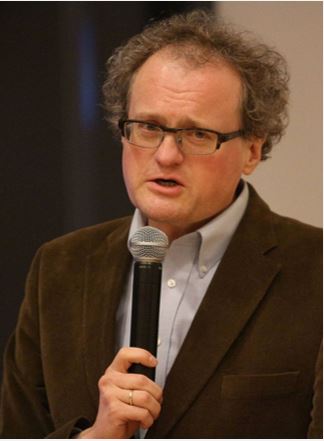
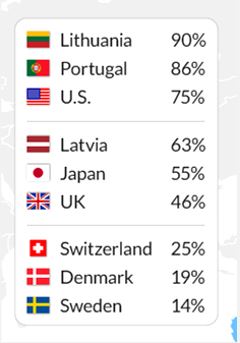
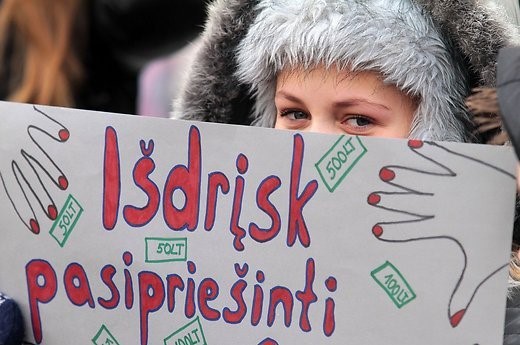


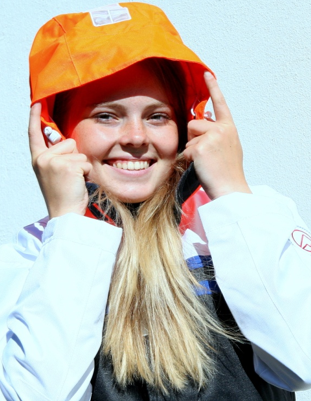
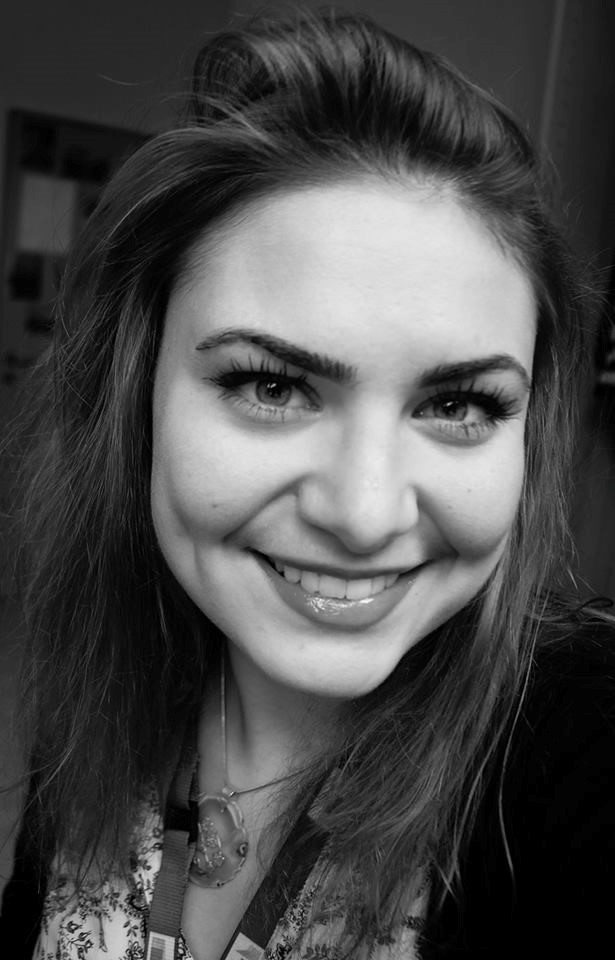
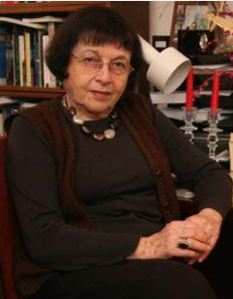
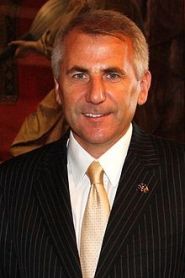
.jpg)
